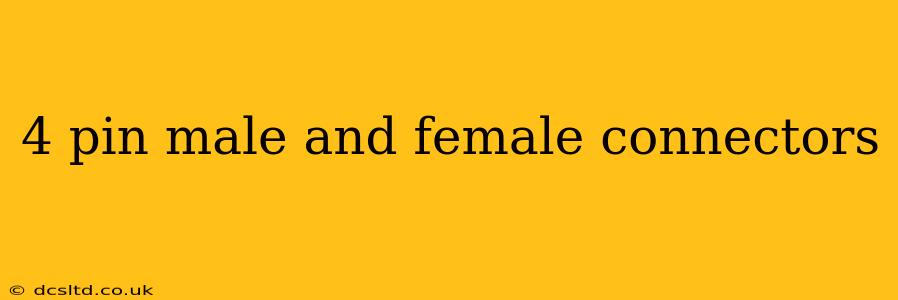4-pin connectors are ubiquitous in various applications, from electronics and robotics to automotive systems and industrial equipment. Understanding their types, uses, and specifications is crucial for anyone working with these components. This guide delves into the world of 4-pin male and female connectors, covering various aspects to provide a comprehensive overview.
What are 4-Pin Male and Female Connectors?
4-pin connectors, as the name suggests, are electrical connectors with four pins designed to establish a connection between two mating parts. The male connector has protruding pins, while the female connector has corresponding receptacles to accept these pins. This simple mechanism allows for a secure and reliable electrical connection. The specific type of connector varies greatly depending on the application and required specifications. These differences can include the connector's housing material, pin arrangement, locking mechanisms, and the size and type of the pins themselves.
Different Types of 4-Pin Connectors
Several types of 4-pin connectors exist, each suited for specific applications. These include:
- JST XH Connectors: Known for their small size and ease of use, these are commonly found in electronics and hobbyist projects.
- Molex Connectors: Often used in power applications due to their robust construction and high current-carrying capacity. Various sizes and configurations exist within the Molex family.
- Wire-to-Wire Connectors: These connectors feature male and female terminals that crimp onto wires, creating a secure and reliable connection.
- PCB Mount Connectors: Designed for mounting directly onto printed circuit boards (PCBs), these are commonly used in electronic devices for internal connections.
- Circular Connectors: While less common with only 4 pins, they offer robust and weatherproof connections, ideal for harsh environments.
Choosing the Right 4-Pin Connector
Selecting the appropriate 4-pin connector requires careful consideration of several factors:
- Application: The intended use dictates the necessary connector type. A connector for a high-power application will differ significantly from one used in a low-power, delicate device.
- Wire Gauge: The thickness of the wires being used will influence the pin size and connector type.
- Current Rating: The maximum current the connector needs to handle is a critical consideration.
- Voltage Rating: Similarly, the maximum voltage the connector can safely handle should be carefully considered.
- Durability and Environmental Factors: The operating environment, including temperature, humidity, and potential exposure to harsh chemicals, will impact the choice of connector material and design.
- Polarity: Ensuring correct polarity is crucial to avoid damage to connected devices. Some connectors utilize keyed designs to prevent incorrect mating.
How to Wire a 4-Pin Connector
Wiring a 4-pin connector involves carefully crimping or soldering wires to the connector pins. Always refer to the manufacturer's instructions for the specific connector being used. Improper wiring can result in poor connections or damage to the connected devices. Proper wire stripping and insulation removal are crucial for a secure and reliable connection. Using the appropriate crimping tool is essential for reliable crimped connections.
What is the difference between a male and female 4-pin connector?
The difference lies in their physical design. The male connector possesses pins that protrude, while the female connector features sockets that receive these pins. This arrangement ensures a secure, mechanically stable connection when the two halves mate.
What are 4-pin connectors used for?
4-pin connectors serve diverse purposes across multiple industries. Applications include:
- Power supplies: Delivering power to electronic devices.
- Data transfer: Transmitting data between components.
- Control signals: Sending control signals to actuators or other devices.
- Sensors: Connecting sensors to data acquisition systems.
- Automotive applications: Used in various automotive systems such as lighting, sensors, and control modules.
How do I identify a 4-pin connector?
Identifying a 4-pin connector involves checking the number of pins or receptacles present and examining its physical characteristics (size, shape, material). Many connectors are clearly marked with their manufacturer's name and part number.
Where can I buy 4-pin connectors?
4-pin connectors are widely available from various electronic component suppliers, both online and offline. Major distributors and online retailers carry a large selection of various types and configurations.
This comprehensive guide provides a solid foundation for understanding 4-pin male and female connectors. Remember always to consult the specific manufacturer's documentation for detailed instructions and safety precautions before handling any connector. Careful selection and proper installation are crucial for ensuring reliable and safe operation.
